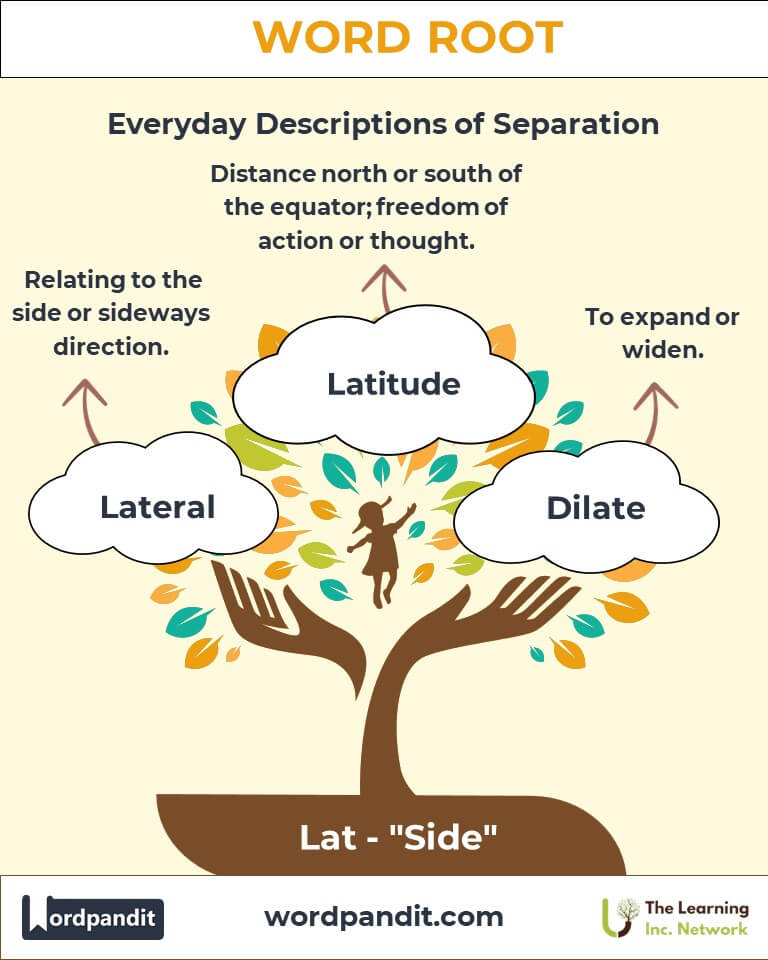Lat: The Root of Sides and Movement Across Disciplines
Byline: Explore the fascinating versatility of the root "Lat," derived from the Latin "latus," meaning "side" or "to carry." From "lateral" movements to "translations" bridging languages, this root seamlessly connects concepts of position, motion, and transformation across fields.

Table of Contents
- Introduction: The Essence of Lat
- Etymology and Historical Journey
- Mnemonic: Unlocking the Power of Lat
- Common Lat-Related Terms
- Lat Through Time
- Lat in Specialized Fields
- Illustrative Story: Lat in Action
- Cultural Significance of the Lat Root
- The Lat Family Tree
- FAQs About the Lat Word Root
- Test Your Knowledge: Lat Word Root Quiz
- Conclusion: The Living Legacy of Lat
Introduction: The Essence of Lat
What do words like lateral and translate have in common? Both are rooted in "Lat," a Latin term meaning "side" or "to carry." Whether describing a football player’s lateral pass or the act of carrying meaning across languages, "Lat" captures the idea of movement, connection, and positioning. Its applications span fields as diverse as sports, linguistics, and geometry, emphasizing its enduring relevance.

Etymology and Historical Journey
The root "Lat" originates from the Latin latus, meaning "side," and lātus, a form of the verb "ferre" (to carry). Over centuries, it has evolved into numerous terms signifying movement along sides or carrying across boundaries. The Middle Ages popularized its use in architecture (bilateral symmetry) and language studies (translation), embedding its significance into intellectual and practical pursuits.
Mnemonic: Unlocking the Power of Lat
Picture a person standing at a crossroads, carrying a map to navigate different paths branching out to the sides. This image captures "Lat" as both a direction and a connection.
Mnemonic Device: “Lat takes you laterally to new sides or carries meaning across boundaries.”
Common Lat-Related Terms
- Lateral (LAT-er-uhl):
- Definition: Relating to the side or sideways direction.
- Example: The lateral movement of the crab allowed it to navigate the sandy shore.
- Translate (TRANS-late):
- Definition: To carry meaning across languages or forms.
- Example: Translating a poem often requires capturing its emotional essence.
- Collate (kuh-LATE):
- Definition: To collect or arrange information systematically.
- Example: The librarian collated documents from various archives.
- Latitude (LAT-i-tood):
- Definition: The distance north or south of the equator, or freedom of thought/action.
- Example: The teacher gave students latitude in choosing their project topics.
- Dilate (DYE-late):
- Definition: To expand or widen.
- Example: The doctor observed how the patient’s pupils dilated under bright light.
Lat Through Time
Latus in classical Latin referred primarily to "side" but expanded over time:
- Medieval Latin: Usage in architecture highlighted symmetry with terms like "bilateral."
- Renaissance: Translation studies flourished, emphasizing the "carrying" of meaning.
- Modern Era: Words like "collate" and "latitude" reflect both literal and metaphorical extensions.
Lat in Specialized Fields
- Sports:
- Lateral: Movements or passes that occur sideways.
- Example: Lateral passes are key strategies in football to maintain ball control.
- Linguistics:
- Translate: Vital in bridging cultural and linguistic gaps.
- Example: Translators must navigate nuances that differ from one language to another.
- Geography:
- Latitude: Determines global positioning and influences climate.
- Example: Countries near the equator experience minimal latitude variation in day length.
- Medicine:
- Dilate: A crucial concept in procedures and diagnoses.
- Example: Doctors dilate pupils during eye exams to assess vision health.
Illustrative Story: Lat in Action
At a bustling international conference, Maria, a linguist, demonstrated the power of translation. As she facilitated communication between French and Japanese delegates, her ability to "carry" meaning across languages not only bridged cultural divides but also fostered collaboration on a groundbreaking research project. Meanwhile, on the football field outside, a coach emphasized lateral movements to outmaneuver opponents. Both examples showcased the dynamic versatility of "Lat."
Cultural Significance of the Lat Root
The root "Lat" symbolizes connectivity and adaptability. From the translation of ancient texts that preserved cultural heritage to the exploration of latitude lines mapping our world, "Lat" underscores humanity’s quest to move, connect, and understand. Its influence persists in arts, science, and global communication.

The Lat Family Tree
- Port (Latin: "carry"):
- Export: To carry goods out of a country.
- Portfolio: A collection carried to showcase work.
- Vers (Latin: "turn"):
- Reverse: To turn back or go in the opposite direction.
- Versatile: Easily turned or adapted for multiple uses.
- Tract (Latin: "pull, draw"):
- Contract: To draw together or agree upon terms.
- Attract: To pull toward.

FAQs About the "Lat" Word Root
Q: What does the root "Lat" mean?
A: The root "Lat" comes from the Latin word latus, meaning "side," or lātus, meaning "carried." It signifies concepts of positioning (side-to-side) or movement (carrying across).
Q: How is "lateral" used beyond sports?
A: "Lateral" is widely used in anatomy (lateral muscles refer to those on the sides of the body), architecture (lateral supports provide stability), and business (lateral thinking involves exploring alternative, "sideways" approaches to problem-solving).
Q: What is the connection between "translate" and "Lat"?
A: "Translate" literally means "to carry across" (from Latin trans = across, and latus = carried). It reflects the act of transferring meaning, context, or language from one form or medium to another.
Q: How does "latitude" relate to "Lat"?
A: "Latitude" in geography refers to the lines running parallel to the equator, defining locations based on their "side-to-side" position. Metaphorically, it signifies freedom or flexibility, as in "latitude of choice."
Q: What does "collate" mean, and how is it tied to "Lat"?
A: "Collate" means to gather and arrange items systematically. It originates from the idea of "carrying together" (Latin col- = together, and latus = carried).
Test Your Knowledge: Lat Mastery Quiz
1. What does the root "Lat" signify?
2. Which word describes side-to-side motion?
3. What does "translate" mean?
4. Which field commonly uses "latitude"?
5. What does "collate" involve?
Conclusion: The Living Legacy of Lat
From its origins in Latin to its dynamic presence in modern vocabulary, the root "Lat" exemplifies the power of language to convey direction and connection. Whether charting geographic lines, fostering communication, or enabling strategic movements, "Lat" remains a cornerstone of expression and utility. Let "Lat" inspire you to explore the many sides of language and movement!












